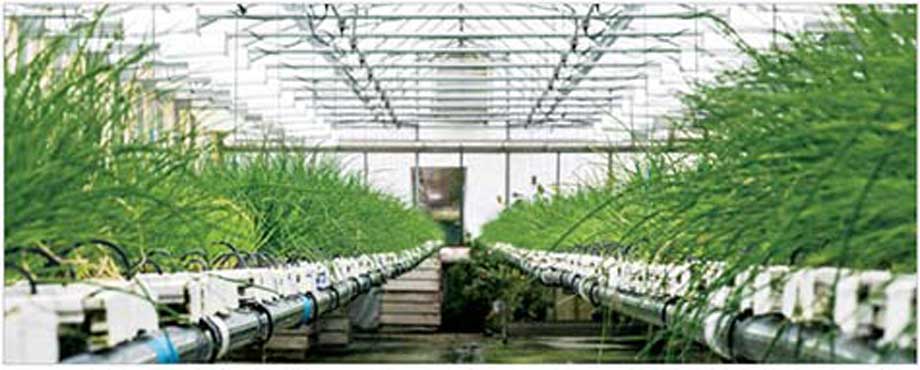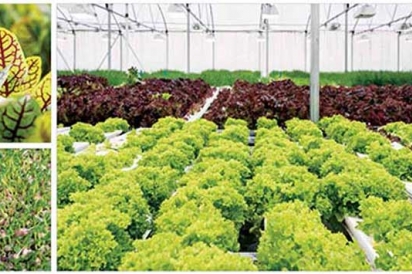A Tasty Oasis
Grateful Greens grows top produce from the inside out
Walking inside Grateful Greens on a frigid February morning is like stepping from the tundra into the tropics.
Outside is the depressing sight of an icy parking lot surrounded by an expanse of half-melted snow, brown dormant grasses and skeletal trees gnawed leafless by winter winds. Inside is verdant life writ large: a half-acre of microgreens, herbs and lettuces thriving below aluminum arches covered in light-permeable plastic. The edible carpet of greenery, suspended nearly chest high in hydroponic troughs, is being hand groomed, harvested and packaged by a staff of six for delivery that day to restaurants and grocers. Watching them tend the myriad plants is surprisingly serene.
“It’s a lot noisier when we run the fans,” says Greg Graft, owner of the 15-year-old Clarksville, Indiana, business. He gestures upward toward a dozen 54-inch fans mounted at the ends of the greenhouses and adds that, if necessary, they could exhaust the air supply within the 20,000 square-foot greenhouse in 1 minute.
“Good air movement strengthens the plants, which is one thing. But if we didn’t provide lot of airflow, we could have powdery mildew in here really quickly, and that’s a problem.”
One might expect Graft to talk more about the dirty hands part of being a greens supplier to so many chefs and grocers in the Louisville area. But since he is a hydroponic grower, there is never any discussion of soil composition or vermiculite or weeding.
The operation is amazingly high-tech, run by computers that constantly monitor temperatures and humidity in the greenhouse, as well the temperature and nutrient content of the water trickling through miles of pipes and troughs. The computer also manages the greenhouse’s metal halide artificial lighting system.
“I can log in from another computer from an outside location to see if there is anything going wrong inside the greenhouse,” Graft says. “This isn’t like your backyard garden, where you plant seeds, water and weed.”
Or watch them grow for what seems like endless weeks before harvest. Using nutrient film technique, plant roots are fed a constant stream of nutrients and water, meaning Graft’s hydroponic greens mature in about one-third the growing time of a natural garden. Without soil, the plants remain grit- and contaminant-free: no Salmonella, no E. coli. The water is continuously recirculated, filtered and resupplied with nutrients.
Yet despite the operation’s sophistication, it’s largely a hands-on business. All of Grateful Greens’ products are started from seed planted by hand in inert medium. Those shoots are tended by hand and harvested the same way. The computer may feed and water the plants, but humans handle every other step in the process.
“It’s the way I’ve always done it, the way I was taught,” says Graft. “We have to harvest something almost every day to keep the plants the right size. You don’t want them getting gangly and long.” Graft learned the trade in the late 1990s under the mentorship of the late Bob Holmes, founder of Creation Gardens. (Holmes later sold that business to current owner Ron Turnier.) Graft was a chef at Equus at the time, and he dedicated himself to learning hydroponic growing when outside the kitchen.
Knowing Graft wanted to get into the business full time, Turnier introduced him to Henry Heuser, co-owner of Henry Vogt Machine Co. and founder of Grateful Greens.
Vogt showed Graft a model of a growing facility operated by Archer Daniels Midland that he wanted to replicate in a spare space at his Old Louisville manufacturing company. The facility would recycle excess carbon dioxide produced by the plants, and use excess heat produced by the manufacturing operation to warm the growing area and the water-based nutrient solution given to the plants.
Despite the clever idea, Graft said they discovered that the model wasn’t viable under those conditions, but he allows it was highly educational.
“We learned that in hydroponics, it’s about root zone temperature, not really the air temperature around the leaves,” he says. “It can get down to the mid-40s in the greenhouse, but as long as the root temperature doesn’t drop below 68°, things are fine.”
In 2009, Graft and Louisville businessman William Walker bought the company from Heuser and built the modern hydroponic system still operating in Clarksville.
Sales have boomed the past few years, driven largely by growth in the number of high-end restaurants opening in the area.
“The white-tablecloth restaurant has been our core customer, partly because we cost more,” says Graft. Several casual spots buy from him also, places like Guaca Mole, Cena and Mussel & Burger Bar and the recently closed La Coop Bistro a Vins among them.
Variety of offerings
Asked to detail the varieties of greens he grows, Graft pauses to consider the range and then says, “A lot,” while smiling.
He quickly reduces his broad summary to “20 different varieties of lettuces, about 10 types of herbs and several edible flowers: nasturtiums, pansies, violas, marigolds, flowering maple.
“In spring and summer, when we have longer daylight hours and quicker growth, we’re able to expand our offerings and do more specific requests from chefs.”
That includes numerous edible shoots, heartier lettuce blends, peppery watercress and mustard greens and a seemingly endless supply of microgreens.
“Chefs have very specific ideas when it comes to their microgreens. Some really want it micro, as in fitting on a single bite,” he says. “Others like them a little larger to use as a garnish.” Bobby Benjamin admits to being one such chef.
“Well, I guess I am kind of picky,” says Benjamin, laughing. Shortly after the 2014 closure of La Coop Bistro a Vins, where he was executive chef, he announced he would open his own restaurant, Butchertown Grocery, in the fall. He’ll tap Grateful Greens again when that happens.
“His are the best greens I’ve ever found in the Southeast; the only thing comparable to the greens I used when I worked in Hollywood,” Benjamin says. “I’m a big fan of everything he does. I just won’t use anyone else’s herbs.”
Benjamin says part of why Graft’s products are superior to local alternatives is because all greens are delivered with their root ball attached. Having it intact rather than removed extends shelf life and fresh appearance dramatically, he says.
Beyond that, he says Graft’s experience as a chef makes Grateful Greens more attuned to the needs of those in the kitchen. “He can relate to chefs, and that’s why his product is so spot on,” he says. “That’s why his has the quality we’re looking for.”
Graft at admits that in the early going, trying to meet the needs of every “Benjamin” in local restaurants was misguided. With an unmanageably large product line, he pared his offerings back to fewer core items and then selected specialty greens to grow at scheduled times and in limited quantities for specific customers.
“It’s hard to keep up with everything they want or see, and I can’t always guess ahead of them what’s going to be the next big thing,” Graft says. “It was a mistake to try way too many different things, but listening to them really helps me keep up with what’s trending.”
Fernando Martinez, co-owner of Guaca Mole, Cena and Mussel & Burger Bar, has been using Graft’s greens since he opened Mojito Tapas Restaurant about a decade ago. (He sold his interest in that restaurant five years ago.) Among his favorite greens are Graft’s red-veined sorrel, baby arugula, watercress and microgreens. “Before he did this, you could not even get decent lettuce in town,” Martinez says. “I really got used to the quality, and then when I moved to Miami, I tried to find something that was as good as his. But there was nothing close to what Greg was doing down there. It was really frustrating.”
Graft is now looking to expand his product line to include blueberries, which he believes he can grow on an empty lot behind his current greenhouse. He said demand for the fruit is skyrocketing, and he’s confident he can feasibly add it to his inventory.
He has had success in the past growing starter plants for sale at local greenhouses and the Douglas Loop farmers’ market, and he also enjoyed a favorable response to heirloom tomatoes he grew last year.
“We definitely would like to look into doing other things because we believe the opportunity is there,” Graft says. Though the business has been open 15 years, he only began selling at farmers’ markets four years ago. “There’s no doubt that the average customer wants this type of product as well. If it complements a salad, it seems that people want it.”
In the meantime, fine-dining chefs such as Annie Pettry, executive chef at Decca, will continue on as the backbone of Grateful Greens’ business. Pettry, who worked in San Francisco restaurants before moving to Louisville, also says Graft’s greens are the only products comparable to those she sourced when in California.
“When I’ve not been able to get things that I was looking for from him, I tried to get them from California, but they always arrived wilted,” Pettry said. “His are always super fresh and they always last a long time.
“But what’s impressive, is they’ll do anything they can to grow something specific for you if you’re interested in it. I always have herbs or greens for salads, micros or flowers of theirs on the menu. It’s just what I prefer.”







